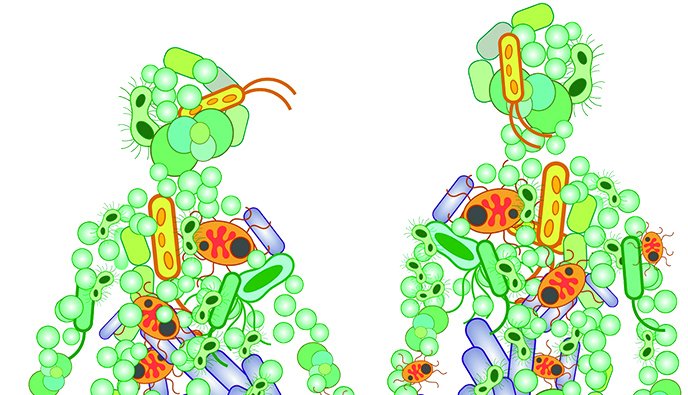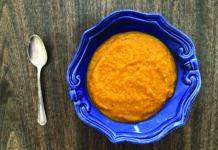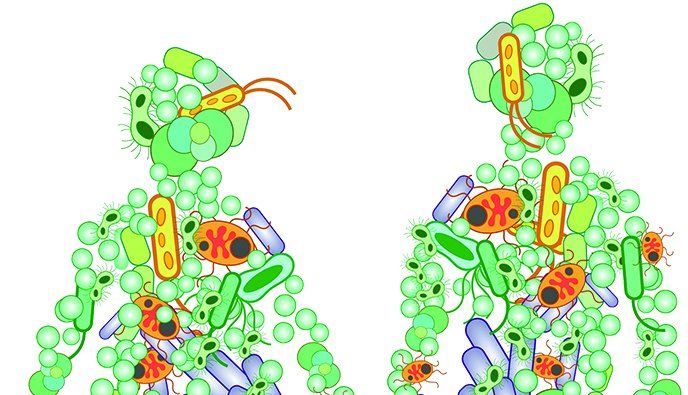Dreamstime.com

Microbes – bacteria and other tiny critters not visible to the naked eye but numbering in the trillions – are busy in your body. Many of these microbes benefit you. Others have the potential to cause harm. This community of microbes is called the microbiota. Their genes are called the microbiome.
“In recent years, we’ve realized our microbiota performs functions – either directly or through the products they make – that could impact the functioning of our body,” says Simin Nikbin Meydani, DVM, PhD, vice provost for research at Tufts University and director of the Nutritional Immunology Laboratory at the HNRCA. “For example, scientists are exploring how the microbiota may be involved in the maturation of the immune system, energy metabolism and how our brain functions.”
That’s not all. Disruption of the normal human gut microbiota has been associated with many different health conditions, such as asthma, allergies, irritable bowel syndrome, obesity, type 2 diabetes, cardiovascular disease and colorectal cancer, among others. Exactly what role the microbiota might play in these conditions is uncertain. But, it’s wise to do your best to support a healthy microbiota.
Managing Your Microbiota:
Many factors impact the makeup of your microbiota, such as your genetics, age, sex, disease conditions, where you live and medications, such as antibiotics. A potentially big influence on your gut microbiota under your control is what you regularly eat.
Eating probiotic-rich foods like yogurt with “good bacteria” may be the first way that comes to mind for shaping the makeup of your gut microbiota. What some people don’t realize is that probiotics aren’t one-size-fits-all. Research shows that certain benefits associated with probiotics, such as supporting immunity or easing constipation, are specific to the species and strain of bacteria. Fermented foods like yogurt typically only contain a few different bacteria, while our gut microbiota is estimated to contain about 1,000 different species.
Another way to influence your gut microbiota is by changing what you “feed” the bacteria. In recent years, scientists have been looking more closely at how what we eat influences which microbes thrive in our body. “There are several components of our diet classified as prebiotics that influence the growth of the microbiota or the products they produce,” Meydani says. “Certain dietary fibers that are fermented by intestinal bacteria but not digestible by people are the main type of prebiotic recognized by scientists.”
“There are other components of food that may also impact the microbiota,” Meydani adds. “For example, there’s some evidence that certain phenolic compounds (phytonutrients) may benefit the microbiota. There’s also a good amount of evidence that certain lipids could impact the diversity and type of microbes that exist in our gut. We’re just starting to learn about all of the different dietary components that could influence the gut microbiota.”
Diversity Matters:
In general, the greater the diversity of the bacteria in your microbiota, the better off your health may be. A loss of diversity of the gut microbiota has been found in several disease conditions, such as obesity, type 2 diabetes and inflammatory bowel diseases (Crohn’s disease and ulcerative colitis), among others.
“We know fiber is protective against conditions like obesity and cardiovascular disease, and this could be related to fiber’s effect on the microbiota,” says Hannah D. Holscher, PhD, RD, assistant professor of nutrition and director of the Nutrition and Human Microbiome Laboratory at the University of Illinois at Urbana-Champaign. “However, intervention trials to show that increased diversity of the gut microbiota is related to decreased incidence of disease are still ongoing.”
“The strongest evidence we have that a diverse microbiota is beneficial comes from research on preventing and treating infections from disease-causing bacteria, such as Clostridium difficile,” Holscher says. “When the diversity of the microbiota is depleted by antibiotic use, some people get Clostridium difficile infections. One of the main symptoms is severe diarrhea.”
To treat Clostridium difficile infections, additional antibiotic treatments are necessary. However, for some people the antibiotic treatment doesn’t work well. Fighting the infection by improving the makeup of the microbiota may work better. “It’s been shown that when physicians do a transplant of the microbiota from a healthy person or from a certified microbiota stool ‘bank’ (available at some hospitals) to the infected person, it can restore the microbiota to a healthier condition and stop the symptoms of the infection,” Holscher says.
Promoting Microbial Diversity:
The diversity of the microbiota of individuals in the US consuming a typical Western diet low in fiber and high in processed foods is generally less than in people in unindustrialized rural communities (such as in some parts of South America or Africa), according to Holscher. That’s partly because the latter group consumes more fiber.
Studies of cross-sections of people across the world suggest the more fiber you consume – especially if from a wide range of plant foods – the more diverse your gut microbiota will be. Additionally, intervention studies in people have shown that consuming more fiber and whole grains increases diversity of gut bacteria.
Different microbes are capable of breaking down (fermenting) different fibers. Holscher explains that it takes different enzymes to break down the various fibers found in foods. Some bacteria have many different enzymes, so they can utilize dozens of different fibers. Other bacteria may only be able to break down one or a few different fibers. By eating a variety of plant foods with different types of fibers, you may encourage the growth of a more diverse population of beneficial microbes capable of breaking down those fibers.
What Microbes Produce:
When microbes ferment fiber, they produce short-chain fatty acids (SCFAs). Some of the main ones are acetate, propionate and butyrate. “SCFAs support the immune system and gut health,” Meydani says. “And, some of them have anti-inflammatory effects.” Over the long term, too much inflammation in our body is associated with increased risk of heart disease, type 2 diabetes and certain cancers.
Recently, Meydani and colleagues completed a trial in which they fed 81 healthy men and postmenopausal women (age 40 to 65) a diet that was either rich in whole grains or refined grains (primarily wheat) for six weeks. Whole-grain wheat is a good source of fiber, including a type called inulin, which is a prebiotic. In refining wheat, more than half (58%) of the fiber is lost.
All food was provided to people in the study and in amounts to maintain their weight. Except for the type of grains, both groups ate the same foods. The whole-grain group averaged 40 grams fiber daily; the refined grain group, 21 grams.
“In the whole-grain group compared to the refined grain group, we saw a modest change in the gut microbiota (based on analyzing stool samples), including an increase in bacteria that produce SCFAs that have anti-inflammatory effects,” Meydani says. “However, we didn’t see an overall decrease in inflammation when we looked at the gut or throughout the body.”
She explains that may be because the changes in the gut microbiota and their products weren’t enough to cause a pronounced effect on inflammation. Also, the time period people ate the whole-grain diet may not have been long enough for a stronger benefit. Other human trials of diet effects on the gut microbiota have typically shown modest effects over the short term, too (unless diet is drastically changed).
“We saw other benefits of consuming whole grains that were independent of the immune system and inflammation,” Meydani adds. “For example, people on the whole-grain diet had a significant increase in their stool weight (which makes elimination easier) and frequency of stools.” The research was published in the American Journal of Clinical Nutrition.
Eating for Trillions:
To nourish your microbiota, Holscher recommends following the government’s MyPlate guidelines (or Tufts’ MyPlate for Older Adults), including trying to eat more fruits, vegetables, whole grains, legumes and nuts. “Really eat the rainbow – getting a variety of colorful plant foods,” Holscher says. “Remember, each plant food contains varying fibers that support different microbes, so getting a variety can help support a healthier gut microbiota.”
She urges people to focus on eating whole plant foods rather than purchasing supplements or other special food products. By eating the whole food, you get phytonutrients, which may also support the microbiota. Plus, focusing on unprocessed and minimally processed foods avoids the risk that processing may have changed the fiber in a way that reduces the ability of the microbiota to utilize it.
Lastly, don’t limit your selection of plant foods to examples listed as containing prebiotics, left. Inulin, one prebiotic, is found in hundreds of plant foods, although in smaller amounts in some. “Also, even if a fiber isn’t fermentable and is not able to provide a specific prebiotic effect, the fiber can still provide a benefit in your gut,” Holscher says. “For example, the fibers in celery aren’t generally fermentable by microbes, but the fibers can still help with regularity, which also supports gut health.” So, enjoy a wide variety of plant foods.
To learn more: American Journal of Clinical Nutrition, March 2017
Your microbiota (bacteria and other microbes) makes up about 3 pounds of your body weight. That’s about what your brain weighs. Microbes are found on your skin and in just about every part of your body, such as your mouth, nose and eyes. But, the vast majority of microbes are in your gut, particularly the large intestine (colon).
To support a diverse, healthy microbiota:
– Make healthy eating a habit. What you eat day in and day out is what impacts your microbiota most.
– Eat a wide variety of plant foods. Challenge yourself to try fruits and vegetables youve never eaten. Check whats in season (for best flavor) and pick up something different each time you shop.
– Choose whole grains instead of refined grains. The higher fiber content of whole grains supports the gut microbiota, among other digestive benefits.
– Meet your fiber quota. On average, women should strive for at least 25 grams of dietary fiber a day; men, 38 grams. Increase intake gradually by eating more whole plant foods (vegetables, fruits, grains and legumes), and drink plenty of water.
– Enjoy yogurt and kefir (fermented milk). Choose ones that note “live and active cultures.”
– Understand antibiotics. The CDC reminds us that antibiotics only treat infections caused by bacteria (not viruses). Antibiotics dont work for the common cold and flu. Learn more at “cdc.gov/getsmart”























